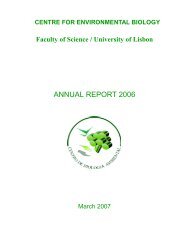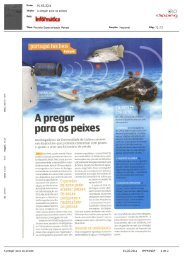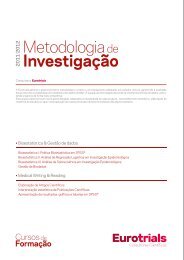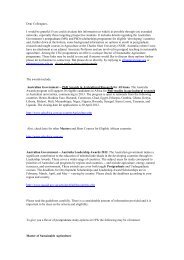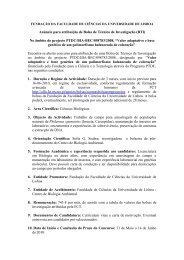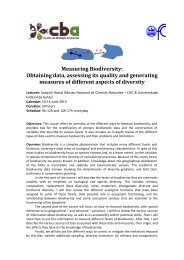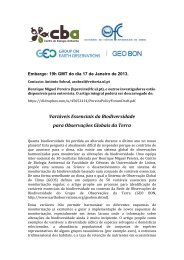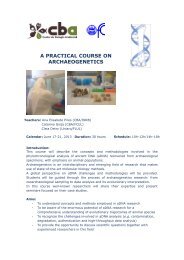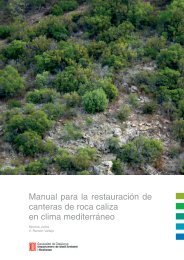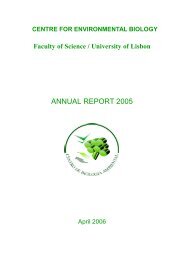European Red List of Vascular Plants - European Commission
European Red List of Vascular Plants - European Commission
European Red List of Vascular Plants - European Commission
You also want an ePaper? Increase the reach of your titles
YUMPU automatically turns print PDFs into web optimized ePapers that Google loves.
a global “biodiversity hotspot” (Mittermeier et al. 2004,<br />
Cuttelod et al. 2008).<br />
Europe has arguably the most highly fragmented<br />
landscape <strong>of</strong> all continents, and only a tiny fraction<br />
<strong>of</strong> its land surface can be considered as wilderness.<br />
For centuries, most <strong>of</strong> Europe’s land has been used by<br />
humans to produce food, timber and fuel and to provide<br />
living space, and currently in western Europe, more than<br />
80% <strong>of</strong> land is under some form <strong>of</strong> direct management<br />
(<strong>European</strong> Environment Agency 2007). Consequently,<br />
<strong>European</strong> species are to a large extent dependent upon<br />
semi-natural habitats created and maintained by human<br />
activity, particularly traditional, non-intensive forms <strong>of</strong><br />
land management. These habitats are under pressure from<br />
agricultural intensification, urban sprawl, infrastructure<br />
development, tourism pressure, land abandonment,<br />
acidification, eutrophication and desertification.<br />
Many species are directly affected by overexploitation,<br />
persecution and impacts <strong>of</strong> alien invasive species, as well<br />
as climate change being set to become an increasingly<br />
serious threat in the future. Europe is a huge, diverse<br />
region and the relative importance <strong>of</strong> different threats<br />
varies widely across its biogeographic regions and<br />
countries. Although considerable efforts have been made<br />
to protect and conserve <strong>European</strong> habitats and species<br />
(e.g. see Sections 6.3, 6.4, 6.5), biodiversity decline and<br />
the associated loss <strong>of</strong> vital ecosystem services (such as water<br />
purification, crop pollination and carbon sequestration)<br />
continues to be a major concern in the region.<br />
1.2 <strong>European</strong> vascular plants: diversity<br />
and endemism<br />
<strong>Plants</strong> are a fundamental part <strong>of</strong> ecosystems, forming<br />
their physical structure, and are <strong>of</strong> essential importance to<br />
the functioning <strong>of</strong> the planet’s atmosphere. The majority<br />
<strong>of</strong> plants conduct photosynthesis, a process that by using<br />
sunlight energy, converts carbon dioxide and water into<br />
organic compounds (such as sugar), water and most<br />
importantly into oxygen. Plant species provide habitat,<br />
enable the life <strong>of</strong> animal species and are primary producers<br />
for the food web. Plant cover significantly influences the<br />
climate, water resources and soil stability and composition<br />
(Hamilton and Hamilton 2006). Humankind has relied<br />
on plants for thousands <strong>of</strong> years for food, shelter, fuel,<br />
fibre, clothing, for medicinal purposes and for their<br />
ornamental and cultural value.<br />
The publication on Centres <strong>of</strong> Plant Diversity (WWF<br />
and IUCN 1994) stated that there are 12,500 vascular<br />
plant species in Europe with 28% <strong>of</strong> the plants being<br />
endemic to the region. More recent figures indicate that<br />
the total number <strong>of</strong> vascular plant taxa in Europe is 20-<br />
25,000 (Euro+Med Plantbase 2006-2011). Twenty four<br />
centres <strong>of</strong> plant diversity have been identified <strong>of</strong> which<br />
nine occur on the Iberian Peninsula and 14 are mountain<br />
ranges (e.g. Alps, Pyrenees, Troodos Mountains and<br />
Carpathians) (WWF and IUCN 1994). The main natural<br />
vegetation is mixed forests. Agricultural expansion and<br />
human settlements have reduced the forest cover to 30%<br />
in Europe (Sharrock and Jones 2009).<br />
The areas with the highest plant richness in Europe are<br />
in the Mediterranean region. The Iberian Peninsula and<br />
Balearic Islands have around 7,500 taxa (species and<br />
subspecies) (Castroviejo 2010), followed by Italy with<br />
6,711 species (Conti et al. 2005). In Greece, the total<br />
number <strong>of</strong> species is around 5,700 (Strid and Tan 1997)<br />
and in France, it reaches 4,630 species (Walter and Gillett<br />
1998). However, per unit area Greece is the country with<br />
the highest concentration <strong>of</strong> native plant species.<br />
The Iberian Peninsula is an important area <strong>of</strong> plant diversity in Europe. Two threatened plant species that are endemic to Spain: Silene hifacensis (left) and Helianthemum alypoides.<br />
Photographs © Javier Fabado Alós and Juan Mota Poveda/Proyecto AFA.<br />
2



